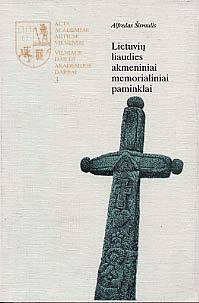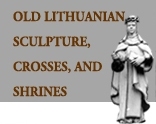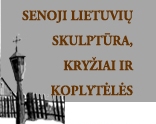- The Lithuanian folk memorial
monuments and theis sculptures were very important and original
small-scale folk monuments and exclusively the spiritual needs of
the farmers. Pillar-type nosses, roofed pillar-type crosses and
miniature chapels with small statuettes (sculptures) in them put
on the
ground or fixed in the trees at firstwere mad e
of special kind of wood became it was connected with the idolatory
Lithuanian traditions when there was worship ritual (ceremony)
between the trees and forfathers. Latter on the
e
of special kind of wood became it was connected with the idolatory
Lithuanian traditions when there was worship ritual (ceremony)
between the trees and forfathers. Latter on the
monuments made ofwoodwere erected by individual families over the
graves of thesis relatives, at the places of accidents, on the
occasion of great blessings or misfortunes. Monuments, which were
made exclusively of stone, weren't rather rare: eleborate iron
crosses used to be fixed in natural field boulders specially
selected for the purpose ofrougheron stems of stone. The
Lithuanian folk memorial monuments made of stone apeared in the
19th century with the building of broken stone (granite) and the
romantism influenced the building of broken stone to apear
neoromanic and neogotic architecture development evoliution in
Lithuania. All is connected with the Lithuanian national
liberation movement, which took part in the seo ).nd half of the
19th
century. Types, form and sculptural stone monuments decoration
folk masters appropriated from the monuments made of wood. The
professional art influenced too.
- The Lithuanian folk masters created
from the stone (granite) mostly only memorial pillar (as
pillar-type crosses) small chapels put on the stone base and
crosses with the relief decor and cementery gates. The spread of
monuments made of stone types in the Lithuanian ethnic regions are
analogical to the spread of wooden monuments (ar they occured in
very ethnicregion of Lithuania). The main characteristic features
of the Lithuanian
folk monuments of stone in the 19th century are large height, the
stone (granite) pillars or separate monumental integrity,
sculptural mounting and finishing whifh white insatiable iron
decorative accent-cross (the Lithuanian small sun).
- The historical situation of the 1st
half of the 20th century wasn't tevourable to the Lithuanian folk
memorial monuments development.
- The cross made of stone was the main
form of monuments spread in the ;econd dacade of the 20th century
in tye Lithuanian contury side. They were constructed in different
compositional and decorative patterns, which included sculpture
and various interpratations of chapel and altar motifs, or there
were several veriations of decorative elements used on crosses:
carvings on the stem and the crosspiece, openwork ornaments fixed
on the stem. The stem and the cross-piece were very freequently
adorned with open-work cuttings (in Highlands) and crosses were
less numerous and decorative elements were used on them rather
sparingly (in the Lonlands).
- In the 20th and 30th years of the
20th century the toms stone monuments made ofstonewerewith
anoakstemwith broken branches orrockwith the cross idea. Only a
miserable fraction of 1 his priceless wealth of memorial
sculptures has survived to the present day - the works of folk
masters as A.
- Raudonis and J. Liaudanskis only.
- The analysis of folk masters -
stone-cutters works nowdays shows a strong influence of the
professional art for theis neation and the changing sculptural
subject.
- The Lithuanian folk
masters-stone-cutters in the 19th and 20th centuries started the
old creative traditions of folk art of the memorial monuments
(architecture). Theirs creationwasn't connected only with earmings
and theirs neat ion wasn't profession. The stone - cutters were
landless peasants, who
- seached for work and pay. In the
soviet years folk masters-stone-cutters achined some professional
results-but this problem needs a special disscussion.
- Folk memorial monuments served the
purposes of visual information about the local people's spiritual
culture the high standards of folk artistic traditions and the
talent of the individual masters. The professional masters,
artists influenced on folk masters-stone-cutters, but the folk
memorial works influenced on the professional art too. The process
is still continuenig now. The serentific generalization of
memorial monuments made of stone is broadening our outlook about
the folk plastic art made of stone.

